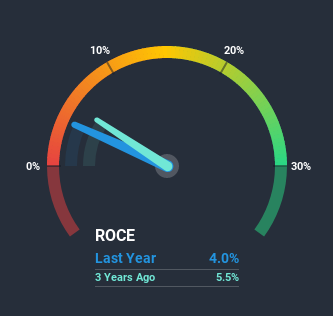The Trends At Cass Information Systems (NASDAQ:CASS) That You Should Know About
If you're not sure where to start when looking for the next multi-bagger, there are a few key trends you should keep an eye out for. One common approach is to try and find a company with returns on capital employed (ROCE) that are increasing, in conjunction with a growing amount of capital employed. Basically this means that a company has profitable initiatives that it can continue to reinvest in, which is a trait of a compounding machine. However, after briefly looking over the numbers, we don't think Cass Information Systems (NASDAQ:CASS) has the makings of a multi-bagger going forward, but let's have a look at why that may be.
What is Return On Capital Employed (ROCE)?
For those who don't know, ROCE is a measure of a company's yearly pre-tax profit (its return), relative to the capital employed in the business. The formula for this calculation on Cass Information Systems is:
Return on Capital Employed = Earnings Before Interest and Tax (EBIT) ÷ (Total Assets - Current Liabilities)
0.04 = US$34m ÷ (US$2.0b - US$1.1b) (Based on the trailing twelve months to September 2020).
Thus, Cass Information Systems has an ROCE of 4.0%. In absolute terms, that's a low return and it also under-performs the IT industry average of 9.4%.
See our latest analysis for Cass Information Systems
Historical performance is a great place to start when researching a stock so above you can see the gauge for Cass Information Systems' ROCE against it's prior returns. If you're interested in investigating Cass Information Systems' past further, check out this free graph of past earnings, revenue and cash flow.
The Trend Of ROCE
In terms of Cass Information Systems' historical ROCE movements, the trend isn't fantastic. To be more specific, ROCE has fallen from 5.2% over the last five years. Meanwhile, the business is utilizing more capital but this hasn't moved the needle much in terms of sales in the past 12 months, so this could reflect longer term investments. It may take some time before the company starts to see any change in earnings from these investments.
On a separate but related note, it's important to know that Cass Information Systems has a current liabilities to total assets ratio of 57%, which we'd consider pretty high. This can bring about some risks because the company is basically operating with a rather large reliance on its suppliers or other sorts of short-term creditors. Ideally we'd like to see this reduce as that would mean fewer obligations bearing risks.
What We Can Learn From Cass Information Systems' ROCE
Bringing it all together, while we're somewhat encouraged by Cass Information Systems' reinvestment in its own business, we're aware that returns are shrinking. And with the stock having returned a mere 14% in the last five years to shareholders, you could argue that they're aware of these lackluster trends. As a result, if you're hunting for a multi-bagger, we think you'd have more luck elsewhere.
While Cass Information Systems doesn't shine too bright in this respect, it's still worth seeing if the company is trading at attractive prices. You can find that out with our FREE intrinsic value estimation on our platform.
While Cass Information Systems may not currently earn the highest returns, we've compiled a list of companies that currently earn more than 25% return on equity. Check out this free list here.
This article by Simply Wall St is general in nature. It does not constitute a recommendation to buy or sell any stock, and does not take account of your objectives, or your financial situation. We aim to bring you long-term focused analysis driven by fundamental data. Note that our analysis may not factor in the latest price-sensitive company announcements or qualitative material. Simply Wall St has no position in any stocks mentioned.
Have feedback on this article? Concerned about the content? Get in touch with us directly. Alternatively, email editorial-team (at) simplywallst.com.

